


|
|
|
|
Here I am in France and
I must admit I am a little intimidated by Paris!
The buildings are so huge, the boulevards so wide, so imposing! It didn't
take me long to reverse my feelings though.
It was late
spring and the chestnut trees were blooming and everything was so green. I
couldn't stand it and started singing April in Paris. Of course everyone then
couldn't get it out of their minds.
The guide laughed because it was May and the
song says April, we were told April is a little early for them to bloom but
April sounds better than May in the lyrics!
I just love the architecture but was
disappointed as they were just finishing the Muse D'Orsay so we didn't get to
see it. The architect, a woman from Italy, is redesigning the old Main Library
of San Francisco to house our world famous Asian Art Collection. Preliminary
plans look great.
Click on this link to view the geographical statistics of France.
One strange thing I learned about the city and why many of the streets had buildings that were setback in different widths is due to the fact that in 1823 the city decided that it was time to pave the streets, they were behind London by about 50 years. When they began paving the streets they passed a law that no one could refurbish the front of their buildings. The reasoning behind this was the belief that after a while the buildings would deteriorate and fall apart. Then the streets could be widened! Of course this didn't happen, the front of the buildings fell apart making the city look even worse. Only after Napoleon decided to redo Paris and widen the avenues, did it resemble the city we know today.
Here
I
am in Paris doing the usual things. A boat ride
on the Seine which is really a treat, around Notre Dame and back to the newer section of Paris and a walk on the Left
Bank!
The guide said she wasn't sure why people thought it was such a great painting but as soon as she said it she knew she shouldn't have. We were mesmerized, just kept staring at it! It seemed that her eyes follow you around where ever you walked!
We also went to the Follies Bergere but after seeing the shows in Las Vegas and Reno they were a lot smaller. Of course at the table next to us were a group from Ohio and they were scandalized, both by the show and the fact that everyone at our table didn't watch the show half of the time because it was too tame for us.
I met two woman on the trip, they were in their 70's and full of life, live in Humboldt
County and we decided to go to lunch somewhere very French. We were trying to decide where to go when the men said, "Lets go to a McDonald and have a
Green Bean Incident!
We had other experiences with food as we traveled around France. The funniest was in the Loire River Valley. We went into a restaurant and the food was terrible. This in France. Everything was tough. The only things decent were the string beans, green. We were pissed, not only was the food bad but when they got to our table they said they hadn't made enough food for everyone so our group would have to cut everything into 18 pieces and share. We were all mad but I really throw a fit. Get us food or else and we all started to pound the table! The maitre di and the waitress cursed us but came out of the kitchen with several big serving trays and when the covers were taken off, they were filled high with green beans. We screamed and laughed and we all ate plates full of baby green beans. Now the staff wasn't sure if they should keep being mad or laugh. We didn't care. The last day of the trip we had a
going away dinner and everyone kept suspiciously quiet. The lights were dimmed and a waiter came out with a big silver dish and in the middle was a can of
green
beans. Everyone laughed and said it was a present to me for at least getting us something eat! I kept that can of baby green beans on a shelf in my bed room as a reminder of the trip. About four years later I came into the bedroom one day and noticed my cat Jennifer was looking at the can because it was
tilted slightly and looked like it was going to explode! I guess it had started to ferment so I thought the best thing to do was to throw it out before I experienced an explosion of baby green beans all over my bedroom, revenge of the French!
In May of 1804 Napoleon crowned himself
emperor here. Full scale restoration started in 1850, it was decided then to
tear down the warren of little buildings in front of the cathedral, creating the
du Paris.
The first level of the facade is the Portal
of the Virgin, Portal of the Last Judgment and Portal of Anne. Above the gallery
is the famous Rose Window and above that the base of the twin bell towers. There
are 387 steps to the top of the towers and allows a close up of the famous
gargoyles and the expansive view of the city.
The interior is supported by 12th century
columns supporting the twin towers. Louis the XIII vowed to decorate the church
if the queen had a son. After 23 years they had a son and he dedicated the
entire country to the Virgin Mary.
Under the square in front of the cathedral is
the Crypte Archeologique museum. It contains the remains of previous churches on
the site, models of the district through the ages and artifacts from 2000 years
ago. Across the street is the Musee Notre-Dame with paintings, engravings,
medallions and other documents and objects charting the history of Notre-Dame.
Seine River Cruise
Photos of Paris
Sidewalk Cafe
Another story I must tell is as follows: I was using hair spray at that time and was running out of this most important item and of all places, in France where you must look good at all costs! I discreetly
left the group and found a drug store. It looked like it was out of the past. The druggist was in his 80's at least and he watched me as I stood there looking at the shelves for hair spray. How difficult could this
be? He sent his assistant, a girl about 18 to help me. I being knowledgeable said something like, les chevaux, no response, said it again, pointed at my hair and went, "Poof" or "Spray" or what ever. She looked at me like I was crazy and finally the old druggist shook his head and leaned over the counter with a bottle and said 5 francs. I just took it and left. Everyone laughed and one woman on the trip said no wonder that poor girl was confused, I probably kept saying the word for horse, not hair and she thought I really was nuts. A horse on head and poof, poof, poof!
We also saw where poor Joan of Arc was burned on the cross by those wicked church men and the king. Also where Leonardo Da'Vinci was buried, so much history.
Le Chateau de Versailles
Versailles is an exception since it is not really a Museum nor it is in Paris. It is, however, the best day-trip you could make while in Paris. Louis XIV built this palace in just 40 years to
Its gigantic proportions (the western facade is nearly 2,000 feet wide) and the masterpieces of French artists and craftsmen were used by Louis XIV to showcase the power of the French Monarchy. Among the finest examples of this architectural splendor, do not miss the Galerie des Glaces (Gallery of Mirrors), the Salond'Apollon, the Royal Chapel and the Petit Apartment.
Take the time to visit the park (over 200 acres) in which you'll find the GrandTrianon, Louis XIV's summer private residence and the Petit Trianon, built by Louis XV and which became Marie-Antoinette's favorite retreat.
Louis XIV, also known as the Sun King, was the most powerful and opulent monarch Europe had seen since the Roman Empire. Political brilliance in this period was matched only by the genius of the writers, architects and musicians generously promoted by the royal court. Alas, all of this exuberance, including Louis XIV's endless wars, had a cost which was to be paid by the entire nation, largely impoverished towards the end of his reign. The growing resentment of the Bourgeoisie, who demanded political rights more in keeping with their expanding power and wealth, would prove to be a political challenge to the king's successors.
Versailles
The cathedral is designated a World Heritage Site by UNESCO, which calls it "the high point of French Gothic art" and a "masterpiece".
The cathedral is well-preserved for its age: the majority of the original stained glass windows survive intact, while the architecture has seen only minor changes since the early 13th century. The building's exterior is dominated by heavy flying buttresses which allowed the architects to increase the window size significantly, while the west end is dominated by two contrasting spires at 105-metre (349 ft) plain pyramid completed around 1160 and a 113-metre (377 ft) early 16th-century Flamboyant spire on top of an older tower. Equally notable are the three great facades, each adorned with hundreds of sculpted figures illustrating key theological themes and narratives.
Since at least the 12th century the cathedral has been an important destination for travellers. It remains so to the present, attracting large numbers of Christian pilgrims, many of whom come to venerate its famous relic, the Sancta Camisa, said to be the tunic worn by the Virgin Mary at Christ's birth, as well as large numbers of secular tourists who come to admire the cathedral's architecture and historical merit.
Chart Cathedral after Versailles
Later the reception for Charles IX was even more magnificent, with young girls and boys outfitted to look like mermaids, nymphs and satyrs. There were fireworks and even a naval battle in the Cher. Both Francis II and Charles IX died young bringing their brother Henri III to the throne. His own classical festivals, featuring the half naked noble ladies of the court as well as the queen's own daughters acting as nymphs, caused quite a sensation. Catherine bequeathed Chenonceau to her daughter-in-law, Louise of Lorraine, wife of Henri III. When Henri was assassinated, Louise retired to the chateau where she lived out her remaining 11 years in prayer and mourning.
Chenonceau next fell into disuse and then in the 18th century came into the hands of Madame Dupin. She was a sponsor of Jean Rousseau and much admired by the locals. In 1864 the chateau was purchased by Madame Pelouze, who set about restoring the building to its earlier splendor. Today one enters the grounds between rows of lovely plane trees. The formal gardens of both Catherine and Diane are on either side of the main castle keep. There is a drawbridge across the moat, leading to a terrace. Here is the original keep, remodeled by Bohier. The chateau is beyond. It is a rectangular mansion with large turrets in the corners. It is built on massive columns resting in the river bottom and then, beyond it is the two-story, 197-foot long gallery on the five arches spanning the river. The entire place is filled with expensive works of art and the floors and walls are themselves masterpieces.
Touring Chateaus
Bottom right photo is a statue of Joan of Arc in Rouen, northern France!
In the trial that followed, Joan was ordered to answer to some 70 charges against her, including witchcraft, heresy and dressing like a man. The Anglo-Burgundians were aiming to get rid of the young leader as well as discredit Charles, who owed his coronation to her. In attempting to distance himself from an accused heretic and witch, the French king made no attempt to negotiate Joan's release.
In May 1431, after a year in captivity and under threat of death, Joan relented and signed a confession denying that she had ever received divine guidance. Several days later, however, she defied orders by again donning men's clothes, and authorities pronounced her death sentence. On the morning of May 30, 1431, at the age of 19, Joan was taken to the old marketplace of Rouen and burned at the stake.
Her fame only increased after her death, however, and 20 years later a new trial ordered by Charles VII cleared her name. Long before Pope Benedict XV canonized her in 1920, Joan of Arc had attained mythic stature, inspiring numerous works of art and literature over the centuries and becoming the patron saint of France. In 1909 Joan of Arc was beatified in the famous Notre Dame cathedral in Paris by Pope Pius X. A statue inside the cathedral pays tribute to her legacy.
It is a wonder ! An architectural feat, a place of pilgrimage, an exceptional site, among the most often visited in France. 22 km away southwest of Avranches, at the far end of the bay stretching from Cancale to Granville, this town/fortress was built on a rocky outcrop with a 1 km circumference and attached to the continent by a dyke. Surrounded by enormous strands of gray silt, "la tangue", the Mont is also the ideal observation point for one of the world's most unique phenomena, the extremely rapid rise of the tides which gradually encircle the island two times a day : an unforgettable show, but dangerous for careless strollers.
The bay of Mont-Saint-Michel and the Mont itself are registered on UNESCO's worldwide patrimony list as a natural and cultural heritage. The bay brings together a large diversity of natural environments that constitute the vastest stretch of salt meadow and polders in France : some seven thousand sheep graze there. Three rivers flow into the bay : the See, the Selune, and the Couesnon, the natural boundary between Brittany and Normandy.
At its origins, the Mont Tombe was a rock that towered above the forest of Scissy. In 709, a tidal wave engulfed the forest, isolating the Mont. That year, legend has it that the archangel Michel appeared three times before the bishop of Avranches, Aubert, to request the construction of an oratory of him. The bishop had a shrine built, and monks moved in soon thereafter...but the present-day abbey was only built in the year 1000. In the XIIth century, the abbey shined forth throughout all of Europe. In 1204, the Marvel's construction got under way, a masterpiece of gothic architecture regarded as the most remarkable part of the Mont. The three levels of the Marvel The Marvel rises in three terraced levels and comprises : The cloister built by Raoul de Villedieu, which enabled monks to meditate facing an immense landscape. The immense refectory, its narrow slit windows and thick walls which support wooden barrel vaults. the Knights room, "chauffoir" and the monks' manuscript room. Outside, Claudine tower is the point of departure for a walking tour of the ramparts, that were built in the XIIIth and the XVth century, and which made Mont Saint-Michel invincible. The abbey was laid siege to during the Religious wars of the XVIth century. During the French Revolution, it even became a prison for common law criminals and certain political prisoners. Many key figures, including Victor Hugo, Chateaubriand, Viollet-le-Duc, etc. denounced this practice which was abolished in 1863 by Napoléon III. The abbey-church steeple, struck and destroyed by lightning, was replaced by a finely worked spire topped by a gold leaf statue of Saint Michel. After so many centuries, the abbey, a sublime catalogue of all architectural styles, is once again home to a few monks. Stairways and a spiral path go round the mount and enable tourists to go down the only street of this small city of 105 inhabitants, replete with half-timbered houses, boutiques, museums, and restaurants.
Of Interest!
As we were touring the buildings we were taken into one room where there was a huge wooden wheel about twenty feet high. The guide said that for a long time people wondered how they managed to get the supplies and tools up to such a great height. They found this room with the remnants of where the wheel's axle was embedded into the walls and then figured out how the wheel worked. A rope was attached to the axle and went down a smooth slope to the ground. Supplies were put into a box and two men would stand in the wheel and start walking. The torque was strong enough because of the size of the wheel to pull very heavy loads up to the abbey. Another ingenious way to move materials. They think wheels like this may have been used in building cathedrals and other large buildings, saving a great deal of labor and time!
Mont St. Michelle
Under the patronage of Francois I, the
artist spent his last years in the nearby
manor house of Clos-Luce, whose
cellars exhibit models of Leonardo.
In the gardens of the Chateau d Amboise overlooking the Loire, a small, intricate chapel houses the tomb of the "Renaissance Man" Leonardo da Vinci.
In Leonardo's final years, the Italian painter, inventor, intellectual and all-around genius spent his time working for the French rulers controlling Milan. In 1515, King Francis I offered Leonardo the title of Premier Painter and Engineer and Architect to the King. Leonardo then moved to France to work for the French monarchy, never to return to Italy. He lived in the Chateau du Clos Lucé in the town of Amboise near the summer palace of the king. Here he focused on scientific studies until his death on May 2, 1519.
Leonardo's wish was to be buried in the church of St. Florentin in Amboise, which took place on August 12, 1519. However the church was demolished during the French Revolution in the late 18th century (and later by Napoleon I). The alleged bones of Leonardo da Vinci were discovered in 1863 and moved to the Chapel of Saint-Hubert in the gardens of the Chateau d Amboise. Today, the tomb can be visited on the left side of the tiny chapel, where two epitaphs (in French and Italian) hang on the wall describing his birth, death, and how he came to rest in the Chapel of Saint-Hubert.
Leonardo da Vince's Tomb
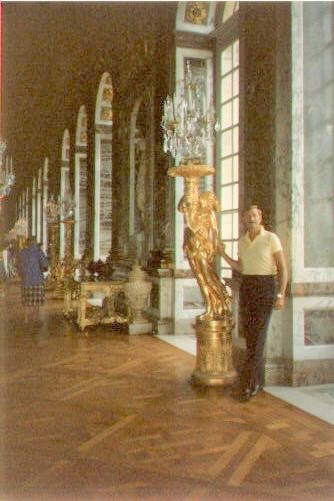

Paris
A Strange Law!
 The second day in Paris we spent the morning touring the Louvre. We were lucky as there were hardly any people in the
r
The second day in Paris we spent the morning touring the Louvre. We were lucky as there were hardly any people in the
r oom with the Mona Lisa. We stood in front of it, about eight feet away and no one bothered us.
oom with the Mona Lisa. We stood in front of it, about eight feet away and no one bothered us.
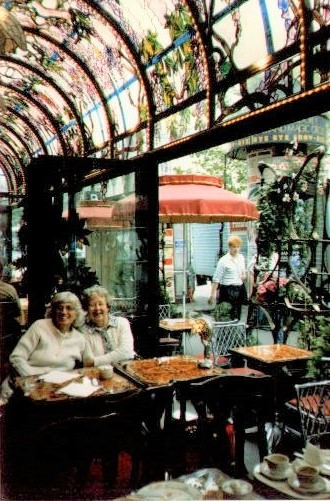 hamburger." Sure we will, they and their wives went down the street and we found an outdoor restaurant, inside was a glass covered ceiling like a Tiffany lamp. We sat outside on the terrace and had a very handsome and snooty waiter which of course didn't bother us as we get that all of the time in the City. A waiter - and they act like their job of delivering food is the greatest thing on earth. We cracked up, decided to have crepe suzettes, wine, then tea. The crepes were made on a wheeled cart with a burner on it and they wheeled it right up to us. Another waiter made the crepes and the filler and was very pleasant. We kept saying "Merci beaucoup" and "Tres bon!" which made him feel good. Fresh fruit was ladled on top and we sat there feeling very grand, eating crepes, wine, and fresh French bread. As we were taking our time, the group that
went to for hamburgers came back and did a double take when they saw us. They laughed and said, "Who do we know in Paris?"
They all wish they had stuck with us instead of having hamburgers. They said the
hamburgers weren't too good and of course I had to tell them that a lot of the hamburger sold in France was made from horses too old to work any more. This went over big and when they asked the guide and she of course agreed with me!
hamburger." Sure we will, they and their wives went down the street and we found an outdoor restaurant, inside was a glass covered ceiling like a Tiffany lamp. We sat outside on the terrace and had a very handsome and snooty waiter which of course didn't bother us as we get that all of the time in the City. A waiter - and they act like their job of delivering food is the greatest thing on earth. We cracked up, decided to have crepe suzettes, wine, then tea. The crepes were made on a wheeled cart with a burner on it and they wheeled it right up to us. Another waiter made the crepes and the filler and was very pleasant. We kept saying "Merci beaucoup" and "Tres bon!" which made him feel good. Fresh fruit was ladled on top and we sat there feeling very grand, eating crepes, wine, and fresh French bread. As we were taking our time, the group that
went to for hamburgers came back and did a double take when they saw us. They laughed and said, "Who do we know in Paris?"
They all wish they had stuck with us instead of having hamburgers. They said the
hamburgers weren't too good and of course I had to tell them that a lot of the hamburger sold in France was made from horses too old to work any more. This went over big and when they asked the guide and she of course agreed with me!
Here I am
behind the cathedral, in the garden away from the maddening crowd, a good place
to relax and think about what you just saw. The Cathedral de
No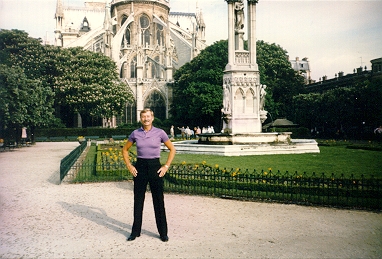 tre-Dame Looms above the large
pedestrian place due Paris on the Ile de la Cite and is the most enduring symbol
of Paris. It was begun in 1163 on a site that was previously a Roman temple. The
chancel and alter were consecrated in 1182. The magnificent statuary wasn't put
into place until 1240. The north tower was finished 10 years later. In the 17
century the statues of the kings of Israel were hacked down by the mod during
the French Revolution because they were "anti-Republican".
tre-Dame Looms above the large
pedestrian place due Paris on the Ile de la Cite and is the most enduring symbol
of Paris. It was begun in 1163 on a site that was previously a Roman temple. The
chancel and alter were consecrated in 1182. The magnificent statuary wasn't put
into place until 1240. The north tower was finished 10 years later. In the 17
century the statues of the kings of Israel were hacked down by the mod during
the French Revolution because they were "anti-Republican".
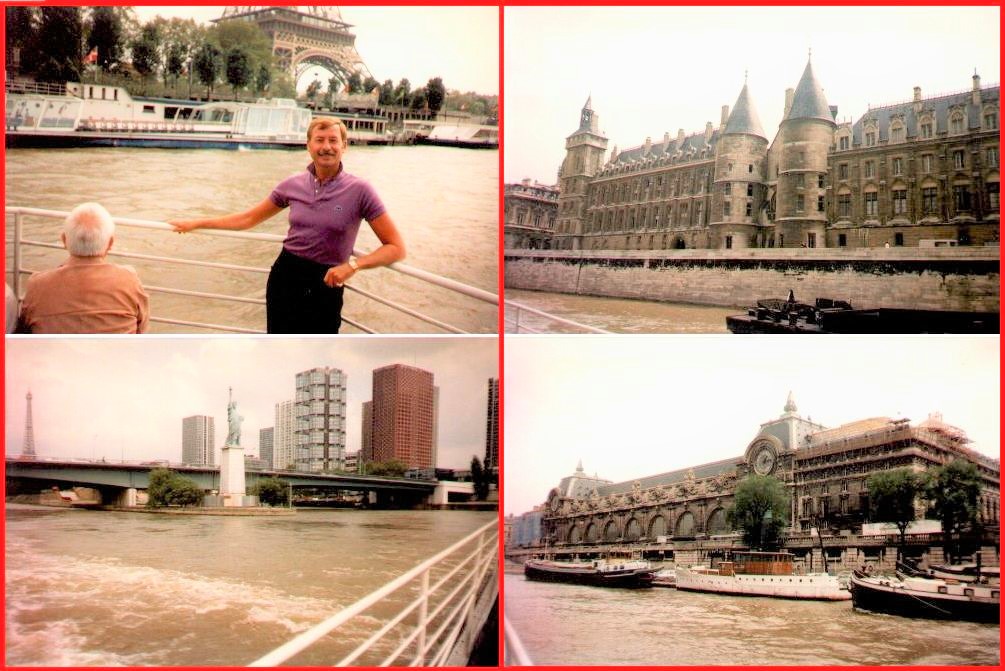
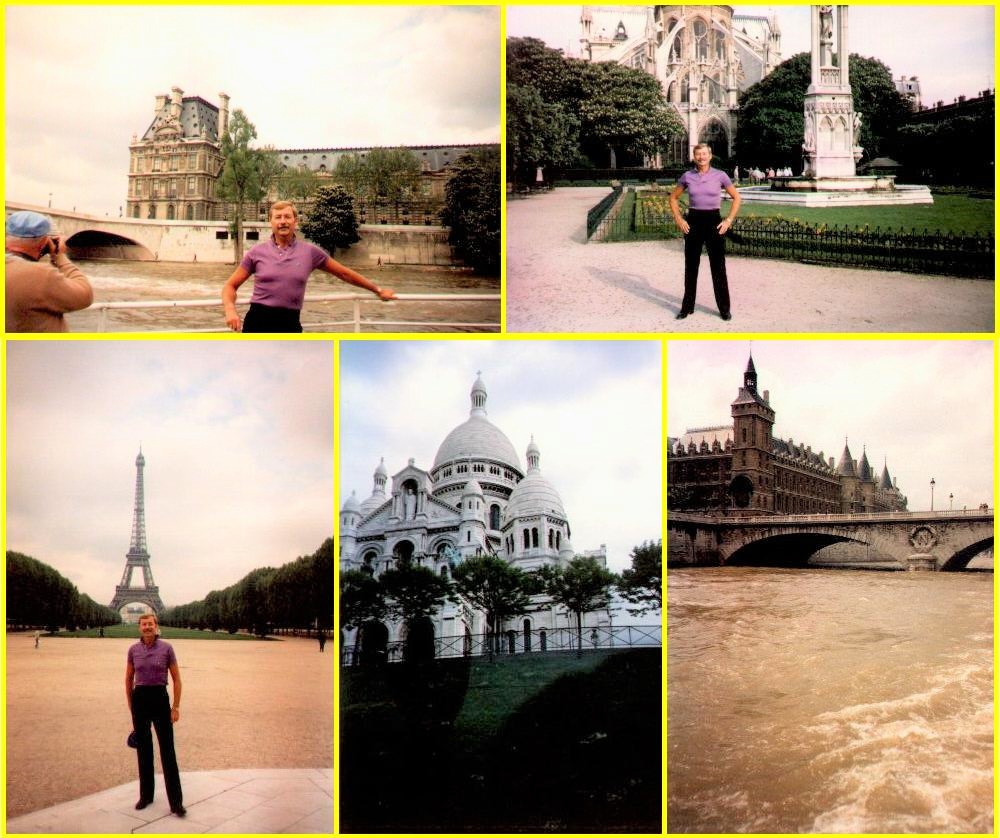

History of the Loire Valley
We left Paris and went to Versailles which is spectacular and then to
Chart and the cathedral. Down to the Loire Valley and Chamborg
and Chenonceau, a fantastic chateaux along with a very interesting history! I didn't realize that the famous circular staircase in Chamborg was designed by
Leonardo Da Vinci
who was buried in France, just picked up that
 information from reading a book on
Chateaux's of the Loire. So much history, so little time!
Then to Mont. St. Michel, a monastery built on a rock that becomes an island everyday as the tide come in.
information from reading a book on
Chateaux's of the Loire. So much history, so little time!
Then to Mont. St. Michel, a monastery built on a rock that becomes an island everyday as the tide come in.
History of Versailles
The 17th century was marked by a period of exceptional power and glamour for the French Monarchy. Starting with King Louis XIII and the Cardinal Richelieu who together transformed the feudal French Monarchy to an Absolute Monarchy, by controlling the opposition of the "Grands" (the Lords) and the growing power of the Protestant (siege of La Rochelle, 1628). Mazarin, Louis XIV's regent, ended the popular revolts of La Fronde. Louis XIV, in turn, managed to keep all the Princes and Lords at his court in Versailles, to better control and display his glorious power.
 make it the residence of the court and the capital of France.
make it the residence of the court and the capital of France.
The following datelines may be of interest to you!

History of the Chartres Cathedral
Chartres Cathedral, also known as the Cathedral of Our Lady of Chartres (French: Cathedrale Notre-Dame de Chartres), is a Roman Catholic church in Chartres, France, about 80 km (50 miles) southwest of Paris and is the seat of the Bishop of Chartres. Mostly constructed between 1194 and 1220, it stands at the site of at least five cathedrals that have occupied the site since the Diocese of Chartres was formed as an episcopal see in the 4th century. It is in the High Gothic and Romanesque styles.

History of Chenonceau
Chenonceau is on the Cher river, a southern tributary of the Loire. It is located practically in the center of the Loire valley country east to west, and centered north to south between Amboise and Loches. The present chateau was built between 1513 and 1521 by Thomas Bohier, collector of Taxes for Kings Charles VII, Louis XII, and Francis I. Up to that time the estate was owned by the Marques family who were financially ruined by their own excesses. The land had to be sold piecemeal. Bohier bought each lot while
wa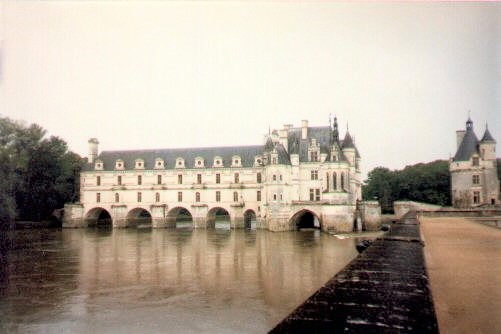 iting for Chenonceau itself to come up for sale. The Marques family realized what was up and tried their best to retain the chateau area, but after 20 years they gave up in 1512. After Bohier bought the old castle he tore down all but the keep. He then began construction of the marvel one sees today. Bohier married Katherine Briconnet, from a family of wealthy financiers in Touraine. Since Bohier was usually off to the wars in Milan, Katherine supervised the re-construction. She insured that the building was no fortress, but a sumptuous palace designed for comfort and convenience. The rooms are located along either side of a central vestibule and it has a straight staircase rather than a spiral one, making service simpler.
When Bohier died in 1524 and Katherine in 1526, King Francis I decided to audit their accounts and conveniently found that Bohier owed the crown so much that the son and heir had to give him the castle as payment. In 1547 King Henri II gave Chenonceau to his mistress, Diane de Poitiers, one of history's all time beauties. She was 20 years older than Henri, but renowned nevertheless. Even when she died at age 67, she is reputed to have looked as beautiful as at 30. She was the widow of Louis de Breze. She always wore black and white in mourning for her late husband and such was her incredible influence that Henri took to wearing mourning also. She built the bridge between the main chateau and the opposite river bank. Michelin mentions that Diane had ample funds from the tax Henri levied on every church bell in France and quotes Rabelais "The King has hung all the bells in the kingdom round the neck of his mare". When Henri died in a tournament in 1559 from the lance wielded by Montgomery, Diane at last was confronted by his widow, the Queen Mother, the formidable Catherine de Medici, who was now regent. Catherine forced Diane to give up Chenonceau, giving Chaumont in exchange, which was a cruel revenge indeed. Catherine proceeded to lay out the magnificent park in keeping with her love of splendor. She added the two story gallery of rooms on the bridge and added further large outbuildings which make the scene so lovely today. The Queen Regent gave sumptuous festivals and receptions at the chateau. One of these honored the arrival of King Francis II and his lovely wife, Mary Queen of Scots.
iting for Chenonceau itself to come up for sale. The Marques family realized what was up and tried their best to retain the chateau area, but after 20 years they gave up in 1512. After Bohier bought the old castle he tore down all but the keep. He then began construction of the marvel one sees today. Bohier married Katherine Briconnet, from a family of wealthy financiers in Touraine. Since Bohier was usually off to the wars in Milan, Katherine supervised the re-construction. She insured that the building was no fortress, but a sumptuous palace designed for comfort and convenience. The rooms are located along either side of a central vestibule and it has a straight staircase rather than a spiral one, making service simpler.
When Bohier died in 1524 and Katherine in 1526, King Francis I decided to audit their accounts and conveniently found that Bohier owed the crown so much that the son and heir had to give him the castle as payment. In 1547 King Henri II gave Chenonceau to his mistress, Diane de Poitiers, one of history's all time beauties. She was 20 years older than Henri, but renowned nevertheless. Even when she died at age 67, she is reputed to have looked as beautiful as at 30. She was the widow of Louis de Breze. She always wore black and white in mourning for her late husband and such was her incredible influence that Henri took to wearing mourning also. She built the bridge between the main chateau and the opposite river bank. Michelin mentions that Diane had ample funds from the tax Henri levied on every church bell in France and quotes Rabelais "The King has hung all the bells in the kingdom round the neck of his mare". When Henri died in a tournament in 1559 from the lance wielded by Montgomery, Diane at last was confronted by his widow, the Queen Mother, the formidable Catherine de Medici, who was now regent. Catherine forced Diane to give up Chenonceau, giving Chaumont in exchange, which was a cruel revenge indeed. Catherine proceeded to lay out the magnificent park in keeping with her love of splendor. She added the two story gallery of rooms on the bridge and added further large outbuildings which make the scene so lovely today. The Queen Regent gave sumptuous festivals and receptions at the chateau. One of these honored the arrival of King Francis II and his lovely wife, Mary Queen of Scots.
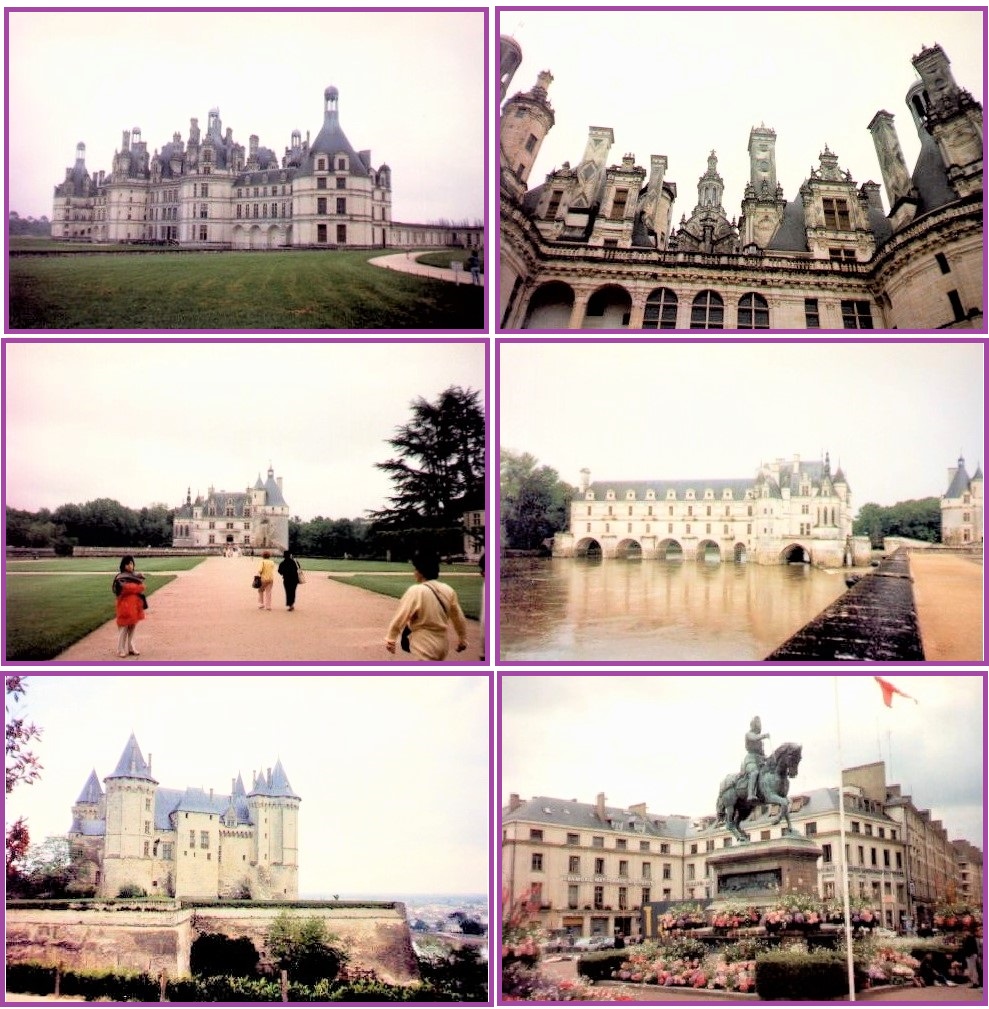
Joan of Arc, a peasant girl
 living in medieval France, believed that God had chosen her to lead France to victory in its long-running war with England. With no military training, Joan convinced the embattled crown prince Charles of Valois to allow her to lead a French army to the besieged city of Orleans, where it achieved a momentous victory over the English and their French allies, the Burgundians. After seeing the prince crowned King Charles VII, Joan was captured by Anglo-Burgundian forces, tried for witchcraft and heresy and burned at the stake in 1431, at the age of 19. By the time she was officially canonized in 1920, the Maid of Orleans (as she was known) had long been considered one of history's greatest saints, and an enduring symbol of French unity and nationalism.
living in medieval France, believed that God had chosen her to lead France to victory in its long-running war with England. With no military training, Joan convinced the embattled crown prince Charles of Valois to allow her to lead a French army to the besieged city of Orleans, where it achieved a momentous victory over the English and their French allies, the Burgundians. After seeing the prince crowned King Charles VII, Joan was captured by Anglo-Burgundian forces, tried for witchcraft and heresy and burned at the stake in 1431, at the age of 19. By the time she was officially canonized in 1920, the Maid of Orleans (as she was known) had long been considered one of history's greatest saints, and an enduring symbol of French unity and nationalism.
Mont St. Michelle
As we left the coast line of Normandy we were all excited about seeing Mont Saint Michel. We kept looking out the windows of the bus and as we approached the very flat coast line we saw in the distance a vision of a pyramidal rock with a church on the upper most region.
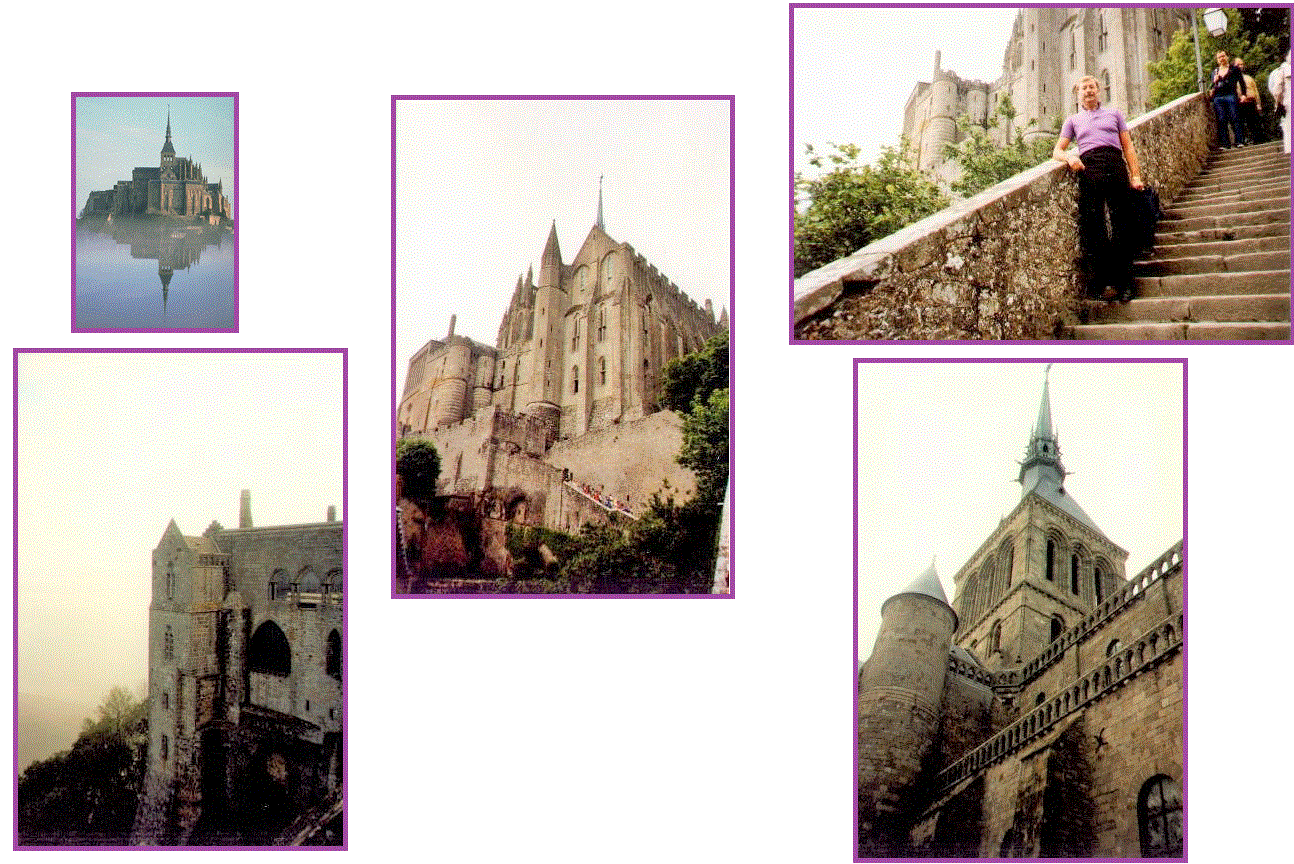
Leonardo Da Vinci
Perched on the ramparts is the Gothic
Chapelle St-Hubert, believed to be the
Leonardo da Vince's burial place.

Created on: 1986

Updated on: 2020.10.23